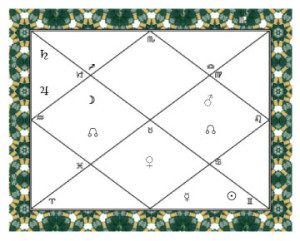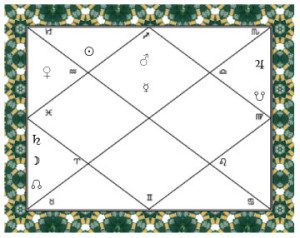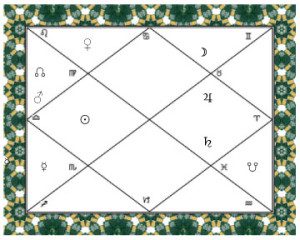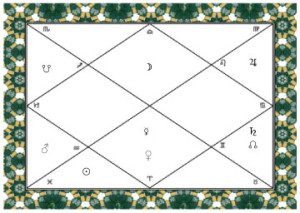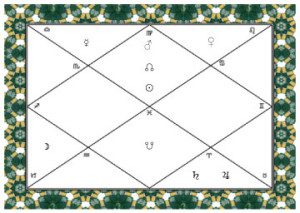Asterisms: A Basic Factor in Jyotir Vidya
By Dharmapad Das/Dean Dominic De Lucia
Sign placement is a basic element in the interpretation of horoscopes in the Vedic, or any other, system. Planetary placements, however, are not limited to the signs but do encompass the famous lunar mansions, also known as asterisms, nakshatras in Sanskrit, and simply as “stars.” To ignore the nakshatras is to ignore the environment that surrounds and influences a planet, or the Moon or the rising degree
There are 27 asterisms, divided into 3 classifications of 7 each. One classification is the deva ganam, or godly asterisms; the second is the manushya ganam, or human asterisms; and finally there is the rakshasha ganam, or the demoniac asterisms.
We may learn by just jumping into it, so to speak, and studying the charts of famous individuals to see how the placement of the rising degree or of the Moon in an asterism was reflective of their personalities.
Lady Diana had Jyeshta rising when she was born. Jyeshta is an asterism whose themes have to do with being outstanding, the seniormost, preeminent and with having executive talents. We can observe from the life of Lady Di that she excelled at her work and did an outstanding job. Also, we can rather safely interpret that her Jyeshta personality led her to outperform her husband, something that she did in many ways; at least to the public eye. She organized her own charity work and her own entourage, such that her executive talents were self-evident. Thus we can see the influence of Jyeshta in her horoscope.
Her Moon occupied the asterism Hasta, and one outstanding theme of the asterism Hasta is “to control, command and allow.” She felt the need to take control over her life and family in spite of being in the stifling royal environment; and she certainly took command over her professional situation. The nature of her feelings are indicated by Hasta.
Ronald Reagan had Moola on the horizon at birth. Shil Ponde, in his book Hindu Astrology, had the following to say about one with Moola on the horizon: “Corresponds to a shrewd, capable character- an organizer who is able to handle people and make them serve his needs through tact and diplomacy. A politician. An orator who is capable of swaying his audiences … the type of person who, while one is still in his presence, holds one spellbound but who, when he leaves, also leaves a lurking distrust behind him” This description of Moola’s influence corresponds so well to Ronald Reagan that the likeness is eerie.
This asterism’s tied-bunch-of-roots symbol suggests suppression (tied and bound) and subjugation of some sort. The suggestion reminds me of how Ronald Reagan seemed intent of suppressing the unions and subjugating workers, all in favor of the industrial elite whom he patronized.
Along the same lines, his lunar asterism Bharani is one of restraint, the essential concept being to check, curb and subdue. In addition to subduing America’s working class, Reagan’s administration was marked for soundly blunting the influence of the former Soviet Union.
Pelé had Pushyami rising. One concept behind this asterism is that it suggests the best of everything. Pelé was awarded the title of the Athlete of the 20th Century and is generally regarded as the greatest soccer player of all time so, obviously, these achievements are the correspondence with the theme of being “the best.”
The Moon sits in Punarvasu, the star of repetition, change and renewal. When Pelé went to NYC to play for the Cosmos, it was a change for him, he reinvented himself and what he was doing; he definitely breathed life into the game of soccer in North America and was the engine of its renewal.
Freedom and the idea of being unfettered correspond to Punarvasu, and also to Pelé’s style of play! He would freely sally forth and attack of his own initiative.
Eric Clapton’s rising star and Moon are both in Swati. In this writer’s book Stellar Horoscopes, he has written: “The rising star was Swati, indicating an autonomous but constantly changing personality. Although the Sun had just gone down when he was born, the Moon was rising. The Moon’s occupation of Swati, too, reinforces this autonomous nature on a deep, emotional level. He didn’t stay with one band and build up his ability and fame from a constant base. Rather, he moved in and out of several bands during his career, the constant thread being none other than he himself, Eric Clapton. Swati is also indicative of his flowing style of guitar playing, just as a sprout swaying in the wind is the symbol of Swati.”
Lennon’s rising asterism was in Uttaraphalguni. Patronage, kindness, favors and granting relief all correspond to this star. No wonder that Lennon championed women’s rights, peace in Vietnam and Humanism in general.
His Moon was in Uttarashada, an asterism that relates to all that is pervading, penetrating and omnipresent, as well as to all that is absorbed. This asterism on the horizon obviously indicates Lennon’s instinct for the impersonal aspect of God, such as the “white light.” In the song Tomorrow Never Knows, he wrote “is it not shining …?”




